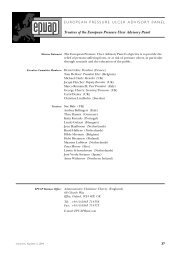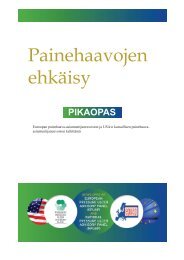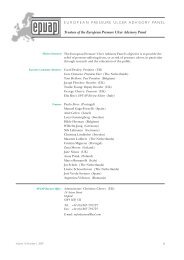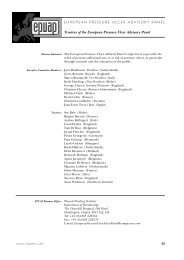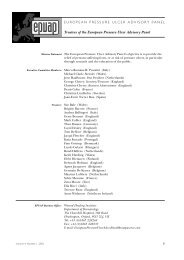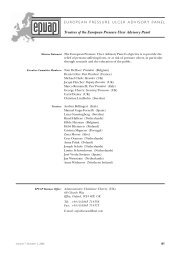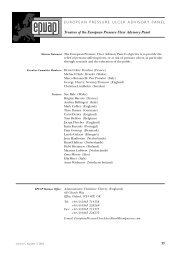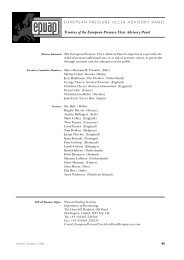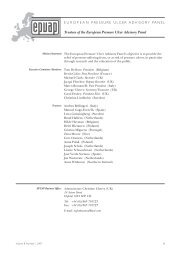SCALE Final Consensus Statement - European Pressure Ulcer ...
SCALE Final Consensus Statement - European Pressure Ulcer ...
SCALE Final Consensus Statement - European Pressure Ulcer ...
Create successful ePaper yourself
Turn your PDF publications into a flip-book with our unique Google optimized e-Paper software.
were all but forgotten in the medical literature<br />
until recently with renewed interest in skin organ<br />
compromise. 4 The fact that two experts in the field<br />
of chronic wounds independently reported the same<br />
clinical phenomenon, with very similar descriptions,<br />
112 years apart, lends credence to the possible<br />
existence of terminal pressure ulcers as a result of<br />
end-of-life skin organ compromise.<br />
Also of historical interest is the original work of<br />
Dr. Alois Alzheimer in Germany. He was on call<br />
in 1901 when a 51 year old woman, Frau August<br />
D, was admitted to his asylum for the insane in<br />
Frankfort. Dr. Alzheimer followed this patient,<br />
studied her symptoms and presented her case to his<br />
colleagues as what came to be known as Alzheimer’s<br />
Disease. When Frau Auguste D. died on April 8,<br />
1906, her medical record listed the cause of death as<br />
“septicemia due to decubitus.” 6 Alzheimer noted, “at<br />
the end, she was confined to bed in a fetal position,<br />
was incontinent and in spite of all the care and<br />
attention given to her, she suffered from decubitus.”<br />
So, here we have the first identified patient with<br />
Alzheimer’s Disease having developed immobility<br />
and two pressure ulcers with end stage Alzheimer’s.<br />
In our modern times, end stage Alzheimer’s Disease<br />
has become an all-too-frequent scenario with<br />
multiple complications including <strong>SCALE</strong>.<br />
In 2003, Langemo proposed a working definition<br />
of skin failure; that it is a result of hypoperfusion,<br />
creating an extreme inflammatory reaction<br />
concomitant with severe dysfunction or failure of<br />
multiple organ systems. 7 Three years later, Langemo<br />
and Brown (2006) conducted a comprehensive<br />
review of the literature on the concept of skin failure<br />
that focused largely on pressure ulcer development. 8<br />
They presented a discussion of changes in the skin<br />
that can occur with aging, the development of<br />
pressure ulcers, multiorgan failure, and “skin failure”<br />
(both acute and chronic as well as end of life). 9-15<br />
In the early 1990’s two publications by Parish &<br />
Witkowski had presented logical arguments about<br />
the mechanism of pressure ulcer occurrence at<br />
the end of life, suggesting that they may not be<br />
preventable in those individuals with multiple organ<br />
failure. 11, 16 Although the term skin failure has been<br />
introduced, it is not currently a widely accepted<br />
term in the dermatological or the wound literature.<br />
Despite the limited scientific literature, there is<br />
consensus from the narrative literature that some<br />
pressure ulcers may be unavoidable including those<br />
that are manifestations of <strong>SCALE</strong>. We propose<br />
that at the end of life, failure of the homeostatic<br />
mechanisms that support the skin can occur,<br />
resulting in a diminished reserve to handle insults<br />
such as minimal pressure. Therefore, contrary to<br />
popular myth, not all pressure ulcers are avoidable. 17,<br />
18<br />
Many members of the <strong>SCALE</strong> Panel acknowledge<br />
the need for systematic study of the phenomenon.<br />
Goals and Objectives of the <strong>SCALE</strong><br />
Panel<br />
The overall goal of the <strong>SCALE</strong> Expert Panel was to<br />
initiate stakeholder discussion of skin changes at<br />
the end of life, a phenomenon that we have termed<br />
<strong>SCALE</strong>. An objective was to examine the concept of<br />
unavoidable pressure ulcers that can occur as a result<br />
of <strong>SCALE</strong>. While reaching consensus on the various<br />
aspects of this topic is an important outcome, this<br />
endeavor will require a more rigorous scientific<br />
investigative approach that was beyond the scope of<br />
this ground breaking meeting. The purpose of this<br />
initial meeting was to generate a series of statements<br />
that will serve as a platform for future consensus<br />
discussions. The objective of this document is to<br />
present these panel statements, disseminate them for<br />
public discussion, and to further the development of<br />
the body of scientific knowledge on this important<br />
topic.<br />
Methodology<br />
A modified three phase Delphi Method approach<br />
was used to reach consensus on the 10 statements<br />
reported in this document. The Delphi Method<br />
relies on expert panel input to reach consensus on a<br />
topic of interest. 19 Our approach consisted of three<br />
separate phases of consensus building involving an<br />
international group of 69 noted experts in the field<br />
<strong>SCALE</strong> <strong>Final</strong> <strong>Consensus</strong> <strong>Statement</strong>, October 1, 2009 Page 5



